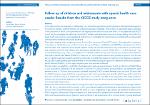Follow-up of children and adolescents with special health care needs: Results from the KiGGS study 2003-2012
Mauz, Elvira
Schmitz, Roma
Poethko-Müller, Christina
The incidence of chronic diseases in children has risen sharply throughout the world. Regardless of the particular diagnosis, chronically ill children and their families are faced with particular challenges. The transition to adulthood leads to changes in the conditions in which care is provided and the responsibilities that are associated with it. In this paper we used KiGGS cohort data to investigate the odds that chronically ill children and adolescents have of no longer feeling chronically ill or facing health impairments in young adulthood. Furthermore, it investigates the factors that are associated with an unfavourable transition from childhood into young adulthood. The analysis employs a data subgroup sourced from the first two waves of the KiGGS cohort – the longitudinal component of the German Health Interview and Examination Survey for Children and Adolescents (KiGGS) conducted by the Robert Koch Institute. The population-based KiGGS baseline survey was carried out between 2003 and 2006 as an examination and interview survey of 17,641 children and adolescents aged between 0 and 17. KiGGS Wave 1 – its first follow-up – was conducted between 2009 and 2012 via telephone. The KiGGS baseline survey used the German translation of the Children with Special Health Care Needs (CSHCN) screener as part of the written questionnaire provided to parents. This formed part of a generic approach towards identifying chronically ill children that applies irrespective of the diagnosis in question. KiGGS Wave 1 used a generic query to gather data on chronic illnesses using two questions taken from the Minimal European Health Module (MEHM); by this stage, the participants had reached adulthood. The information provided by 3,243 KiGGS cohort participants (who were aged between 18 and 24 at the time of KiGGS Wave 1) was analysed for indications of the presence or absence of a chronic disease among children and adolescents aged between 12 and 17. This was done using data gathered using the CSHCN screener between 2003 and 2006. Six years after the KiGGS baseline survey, half of the 509 participants who had screened positive (50.6%; 95% CI 44.4-56.8) stated that they were still chronically ill or faced health impairments. In contrast, one fifth of the participants who had provided no evidence of a chronic illness at the time of the KiGGS baseline survey (21.1%; 18.9-23.4) stated that they were now chronically ill or faced health impairments. Adolescents with a chronic illness reported being chronically ill in young adulthood more frequently than younger children (OR 1.8; 1.02-3.3). Bronchial asthma among 12- to 17-year-olds who had screened positive is associated with a reporting of chronic illness or health restrictions in later life (OR 3.5; 1.6-7.6). Regardless of age, obesity, the presence of asthma or an ADHD diagnosis, chronically ill boys who report pain, and chronically ill children from families with a low socio-economic status and few personal resources (personal protective factors), are at particular risk of a chronic illness in young adulthood.

